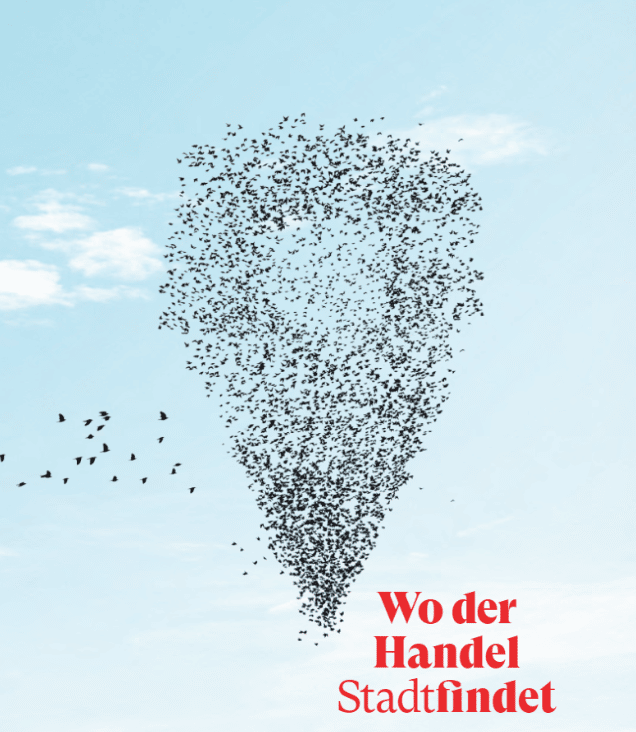- 20. December 2022
Where trade finds "city”
Review, insight, overview: Retail development is a topic with ever-changing variations. An outlook.

Many municipalities are facing profound structural change
Tenant demand for new space in many cities and locations had already declined significantly before Corona, and now the former landlord market has finally turned into a tenant market. The same is also true, broadly speaking, in the hospitality and service sectors. The isolated positive reports regarding rising re-letting rates and sales rising toward pre-Corona levels (which are not adjusted for the online share among stationary retailers) in the retail sector should not obscure the need for far-reaching structural changes to sustainably revitalize the city centers.
The extent of the changes underway and those still to come clearly shows that retail can no longer continue to act as the most essential guarantor of highly frequented city centers. More than ever, vibrant downtowns depend on a functioning overall system with a variety of uses. The Federal Ministry of the Interior assumes that retail will concentrate on the better areas of inner-city locations. At the same time, tenants previously displaced to more favorable locations, for example from the grocery sector, but also innovative concepts/offers with decreasing rent requirements of the owners are likely to move in.
Opportunities, goals and tasks
In the meantime, the first results of the empirical scenario study #elasticity by Fraunhofer IAO with the innovation partnership "Innenstadt 2030+ | Future Public Space" are available, in which six concrete recommendations for action were ultimately derived based on twelve future fields. These are being transferred into practice and accompanied in the first so-called real experiments.
The German Federal Ministry of the Interior (BMI) published a detailed paper entitled "Inner City Strategy" through its "Inner City Advisory Council" in July 2021. At the same time, the federal program "Zukunftsfähige Innenstädte und Zentren" (Sustainable Inner Cities and Centers) was launched to support cities and municipalities in the development of innovative concepts and action strategies and their implementation. Municipalities are thus to be supported in the further development of resilient city centers and town centers.
Scenarios for selected trading situations
What conclusions can be drawn for different retail locations, taking into account the respective framework conditions? From the point of view of the property owner, what are the prerequisites for a sustainably successful retail property, and what adjustments are promising or even necessary?
Even if, of course, especially in times of complex changes, the well-known principle applies all the more that each retail property must be analyzed and assessed individually for each location together with its catchment area: In order to achieve a successful positioning, there are transferable criteria for the stabilization and further development of the various retail property types.
Probably the most complex challenge is faced (once again) by the centers of our cities, the so-called A and B locations of retail. Retail, culture, education, gastronomy, leisure, housing and public life - all facets of the diversity of inner-city uses are directly or indirectly affected by changes in consumer lifestyles, consumption habits and behavior. In this context, retail is and will remain an integral part of urban life - it is one of many incentives to visit.
However, the demands on the interaction of inner-city players have increased considerably. At best, a city center would have to be curated year-round with the participation of all stakeholders. Experiences from established city management, business improvement districts (BID) and also center management can certainly provide valuable pointers for further developing cooperation. Does this also apply to other retail locations?
Local district centers and smaller shopping centers face challenges
Key characteristics of medium-sized retail centers are the mostly smaller catchment areas and the reduced number of tenants/stores due to the smaller area size compared to centers in large cities and larger shopping centers. Even if a product mix tailored to the catchment area is usually achieved, there is often a lack of contemporary anchor tenants with charisma and individual sectors are sometimes only weakly represented.
Tenant failures, as is increasingly the case in the non-food segment, directly leave entire gaps in supply. The discerning consumer, however, expects the broadest and deepest possible range of products and services when he or she visits a store.
Looking at many current changes, one can note a low resilience of the retail locations mentioned. However, "minor changes" can also have a positive effect. The ideal solution would therefore be to increase the resilience to and adaptability to future requirements and, at the same time, to create demand-oriented and identity-forming offers for the population of the catchment area.
What exemplary measures could this be in a medium-sized city*?
True to the principle of "turning those affected into those involved", it is necessary to organize and establish a network of those involved in the sense of an action alliance with a broad participation structure. Communication is the essential task. A central point of contact is the linchpin for driving the necessary processes and keeping them moving. Capacities must be made available for this purpose and a tangible goal must be developed at an early stage. In the future, administration can also establish itself as a "networker" (see #elasticity, 6/2021).
The public sector also has a central function here as a local administration with access to and also responsibility for public spaces. Infrastructural measures in particular can hardly become a reality in the short term due to necessary planning and financing lead times as well as implementation times. Nevertheless, in order to maintain the aroused commitment to complex and long-term urban redevelopment measures, visible results are needed quite quickly. Thinking in terms of construction phases helps to make at least partial results tangible more quickly in the case of far-reaching large-scale measures (e.g., infrastructural changes).
Experience has shown that residents start investing in their properties at the latest when municipal investments begin to be implemented. The increasing willingness to consider and implement mixed uses contributes to the revitalization and increased attractiveness of the respective environment.
Existing retail areas must be examined in particular for the need for adaptation during change processes. Pure retail locations and also smaller shopping centers will remain important retail focal points, but they must be adapted to meet demand. A structure that has been further developed in the direction of mixed use makes a significant contribution to establishing new visitor incentives and at the same time to securing the value of the real estate in the long term.
Ongoing support through active communication in all phases of increasing changes and improvements not only serves to inform, but can even increase the desired bonding effect of the population. Rounding off information events also create reasons to visit and at the same time convey impressions of the improvements achieved. As a side effect, intermunicipal exchange is promoted: Municipalities benefit from experience, and visitors are given further incentives.
All in all, it can be assumed that the mix of uses in the above-mentioned location will increase significantly. This also applies to the shopping centers located there, as is already evident with the former department stores.
Local supply centers stable in the market
The established function of local supply centers is a guarantee for success: The focus on periodic demand leads to regular supply purchases, which have a stabilizing effect on sales. If the situation in this segment is to improve, the focus is on the need for design measures, especially for existing, older local supply centers. In addition to the modern revitalization of the buildings, the open spaces must be upgraded. Quality of stay and quality and mix of offerings are of equal importance here.
Against the backdrop of the necessary change in traffic patterns and also as a general quality requirement for residential areas, municipalities are increasingly planning decentralized structures that enable supply at the district or even neighborhood level.
At these locations, additional uses in the areas of health, care, education, gastronomy and other services can, at best, lead to the emergence of a (completely new) neighborhood center. Such agglomerations of uses not only offer development advantages, but also have a social function, increase the identity with one's own residential environment and thus the quality of life. Naturally, the integrated provision of residential space reinforces these effects and contributes to the sparing use of land in general.
Retail parks on the outskirts of towns and cities as crisis winners with a need for adaptation
The main characteristics of retail parks are the large retail areas with an extensive focus on local supply, supplemented by non-center-relevant offerings in furniture and home improvement stores as well as large non-food offerings such as textiles, consumer electronics, books, toys and household goods. The quantity, but also the quality of the overall offering regularly reaches a large catchment area. Locations on the outskirts of towns and cities perform an important function in supplying the neighboring, often rural areas, where retail offerings decline as population density falls. The high proportion of everyday goods was also the basis of the store's continuing success, even during the pandemic.
The general changes in the retail sector, especially the upheavals in the non-food segment, naturally also affect the retail parks. The following factors are decisive for the future success of retail parks:
- Modernization of the local supply segment in line with customer expectations. A combination of a large-scale full-range retailer with a discount retailer is needed to cover the desired range of products and prices. In addition, changes in eating habits require supplementary offerings in the organic segment and, at best, in fresh and regional products as well.
- 2. At the same time, customer-oriented and location-appropriate additions to the range of retail and service products are expected. Despite the changes in the nonfood segment, there will still be demand for assortments such as clothing, consumer electronics, books, household goods and gifts at large-area locations. Gastronomy makes an important contribution to rounding off the product range and indirectly to improving dwell quality and extending dwell times.
- The increasingly dynamic changes in retailing and the demands of new usage mixes must be responded to by adapting the layout and design of the space. This requires not only the necessary willingness and ability to invest on the part of the owners, but also the flexibilization of the mostly rigid planning regulations.
- Overall, a holistic, interdisciplinary target concept is also required for retail parks. Unlike in the locations described above, the initiative here can come primarily from the owner side, since no preliminary municipal work is usually necessary in the surrounding area. However, early coordination and cooperation with the local administrations is of great importance in view of the necessary embedding in the municipal considerations on the development of centers and trade for the entire city and the usually necessary change in the legal planning requirements
Conclusion
The continuous processes of change in cities can and must be perceived as a challenge. However, they are not predetermined in their outcome, but can be shaped individually and constructively through the interaction of politics, business and civil society. All players in the real estate industry must play an active role in this process in the future. Involving the population as a target group for the changes is a key success factor, from the collection of ideas to the acceptance of the results achieved.
Cooperation between private and public stakeholders/actors is gaining in importance overall. The often-cited increasing mix of uses in neighborhoods and buildings is not only a prospect for future successful and at the same time livable structures. At the same time, as a centuries-old characteristic of the European city, it is also a retrospective and the basis for a transfer to our time. The fact that the flexibility advantages of mixed-use are now also recognized by investors and cities makes us optimistic for the further development of our commercial areas and cities.
By Jörg Wege, MEC

